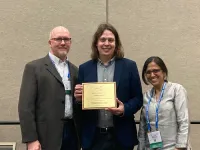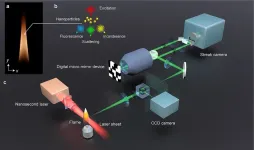(Press-News.org) Although genetic mutations in BRCA1 or BRCA2 are associated with a younger onset of breast and ovarian cancer, women with these genetic mutations continue to face a high risk of cancer incidence after age 50, even if they have not been previously diagnosed with cancer. This is according to a new study led by Kelly Metcalfe, a professor at the Lawrence S. Bloomberg Faculty of Nursing.
The study published recently in the American Cancer Society Journal Cancer, followed over 2000 women between the ages of 50 to 75, from 16 countries, who were aware they had a BRCA mutation and had no previous diagnosis of cancer. The study found that the cumulative risk of these women developing any type of cancer after the age of 50 was 49 percent for those with a BRCA1 mutation and 43 per cent for those with a BRCA2 mutation. For those in the study cohort who had not undergone a cancer risk-reduction surgery, the risk was even greater at 77 per cent for those with a BRCA1 mutation and 67 per cent for those with a BRCA2 mutation.
“What is striking about our results is that breast and ovarian cancers were the most frequently observed cancers occurring and that is concerning, considering we know how to reduce the risk of cancer in women who have these genetic risk factors,” says Metcalfe who is also a Senior Scientist at Women’s College Hospital.
Of the women included in the study only 15 percent underwent a preventative bilateral mastectomy, and 43 percent a bilateral salpingo‐oophorectomy (BSO) – removal of both ovaries and fallopian tubes – before the age of 50. The study found that these women had the lowest risk of any occurrence of cancer at just 9 per cent.
“Our analysis highlights the effectiveness of these risk reduction surgeries, and emphasizes the need for individuals as well as health care providers, to consider clinical guidelines and recommendations for their cancer risk, including how their genetics might impact them even at a later age,” says Metcalfe.
She acknowledges that there are some limitations to the study including the fact that in some countries access to risk reduction surgeries may be limited, and knowledge of how often or whether these women received genetic counselling was not assessed.
“We are not aware of whether the participants in our study received additional counselling about their elevated risk of cancer as they age and we are also unable to determine why some of these women chose to forgo preventative surgery before the age of 50,” says Metcalfe. “However, it is important to point out that screening alone only reduces mortality risk by increasing the chances of detecting the cancer early, it does not reduce the risk of cancer occurring.”
Understanding the limitations of screening is of particular importance for women with either a BRCA1 or BRCA2 mutation especially in assessing their risk of ovarian cancer, as no good screening method exists to detect the cancer early enough. Metcalfe’s study references the National Comprehensive Cancer Network (NCCN) guidelines where it is recommended that women with a BRCA1 mutation undergo a BSO between ages 35-40 and those with BRCA2 mutation between 40-45.
Future studies says Metcalfe, will look at exploring women’s decision-making around whether or not to undergo surgery and their own understanding of risk. For now, Metcalfe is hopeful that advances in genetic testing will help make it more accessible to all women who want to know their risk status.
The Screen Project Canada, housed at Women’s College Hospital, is one example of a consumer-based model of testing where individuals can pay to access genetic testing that allows anyone, regardless of family history, to find out if they carry a BRCA1 or BRCA2 mutation. While it currently operates at a small cost to the patient, Metcalfe believes that lower barriers to genetic testing will not only save lives, but eventually become a mainstay of cancer care in Canada.
“It has been over 25 years since clinical testing for BRCA1 and BRCA2 began in Canada and the United States, we have come a long way in reducing cancer incidence, but not far enough,” says Metcalfe. “The majority of cancers resulting from these two genes are preventable, we need to be offering women the best chance at a cancer-free life.”
END
Risk of cancer remains high for women over 50 with genetic BRCA1 or BRCA2 mutation
New study examines rates of cancer occurrence and whether women are opting for risk-reducing surgeries
2023-02-24
ELSE PRESS RELEASES FROM THIS DATE:
Cleft lip and palate surgery procedures are undervalued, study suggests
2023-02-24
February 24, 2023 – Plastic surgery procedures performed to correct cleft lip and palate deformities in infants and children are economically undervalued, relative to pediatric craniofacial procedures, concludes an analysis in the March issue of Plastic and Reconstructive Surgery®, the official medical journal of the American Society of Plastic Surgeons (ASPS). The journal is published in the Lippincott portfolio by Wolters Kluwer.
The study finds unbalanced allocation of relative value units (RVUs) used in billing and compensation for cleft surgery in children, compared to craniofacial procedures, report Roberto L. Flores, MD, of Hansjörg ...
Insomnia tied to greater risk of heart attack, especially in women
2023-02-24
People who suffer from insomnia were 69% more likely to have a heart attack compared to those who didn’t have the sleep disorder during an average nine years of follow-up, according to new research being presented at the American College of Cardiology’s Annual Scientific Session Together With the World Congress of Cardiology. In addition, when looking at sleep duration as an objective measure of insomnia, researchers found that people who clocked five or fewer hours of sleep a night had the greatest risk of experiencing a heart attack. People with ...
Health, not age, driving a rise in pregnancy complications
2023-02-24
Rising rates of adverse pregnancy outcomes, such as hypertensive disorders of pregnancy, preterm birth and low birthweight, over the past 10 years are largely attributable to the health status of a person before they get pregnant, rather than age, according to a study presented at the American College of Cardiology’s Annual Scientific Session Together With the World Congress of Cardiology.
The study found that the average age of pregnant individuals rose from 27.9 years in 2011 to 29.1 years in 2019, yet age accounted for only a small portion of the marked increase ...
Technology-assisted pregnancies have twice the risk of preeclampsia
2023-02-24
People who became pregnant using assisted reproductive technologies were found to be over twice as likely to develop preeclampsia than those with traditional pregnancies, according to a study presented at the American College of Cardiology’s Annual Scientific Session Together With the World Congress of Cardiology.
The study, based on an analysis of health records from over 2.2 million patients, is the first to assess how reproductive technologies may affect the risk of cardiovascular complications during pregnancy on a national scale. Preeclampsia is a pregnancy-related complication involving new onset high ...
Frequent marijuana use linked to heart disease
2023-02-24
People who used marijuana daily were found to be about one-third more likely to develop coronary artery disease (CAD) compared with people who have never used the drug, according to a study presented at the American College of Cardiology’s Annual Scientific Session Together With the World Congress of Cardiology.
As cannabis becomes legal in an increasing number of U.S. states, this study is among the largest and most comprehensive to date to examine the potential long-term cardiovascular implications of using the drug. CAD is the most common form of heart disease and occurs when the arteries that supply blood to the heart ...
Cognitive behavioral therapy delivered via smartphone app lowers blood sugar, improves health behaviors in patients with diabetes
2023-02-24
People with Type 2 diabetes who were given a smartphone app that delivers personalized cognitive behavioral therapy (CBT) saw significantly greater reductions in their blood sugar and less need for higher doses of diabetes medications at six months compared with those who only received standard diabetes care and a control app, in a study presented at the American College of Cardiology’s Annual Scientific Session Together With the World Congress of Cardiology. A clear “dose effect” was seen, with patients completing more CBT lessons seeing the greatest benefits.
“When studied in a large randomized controlled ...
Is the middle Cambrian Brooksella a hexactinellid sponge, trace fossil or pseudofossil?
2023-02-24
More than 100 years ago, Charles Doolittle Walcott from the Smithsonian Institution was asked to examine strange star-shaped fossils with lobes hailing from the ~ 514-million-year-old Conasauga Formation in Alabama. Walcott described these odd fossils as jellyfish that likely floated in the middle Cambrian seas of what is now the southeastern United States. Little did he know that the Cambrian fossil he named would cause over 100 years of controversy.
The controversy hinged on the interpretation of what Brooksella really was: Was it truly a jellyfish ...
The Biophysical Journal names Carlas S. Smith the 2022 Paper of the Year-Early Career Investigator awardee
2023-02-24
ROCKVILLE, MD – Carlas S. Smith, PhD, of Delft University of Technology, the Netherlands was honored as the recipient of the Biophysical Journal Paper of the Year-Early Career Investigator Award at the 67th Annual Meeting of the Biophysical Society, held February 18-22 in San Diego, California. This award recognizes the work of outstanding early career investigators in biophysics. The winning paper is titled “Precision in Iterative Modulation Enhanced Single-Molecule Localization Microscopy.” The paper was published in ...
New discovery sheds light on very early supermassive black holes
2023-02-24
Astronomers from the University of Texas and the University of Arizona have discovered a rapidly growing black hole in one of the most extreme galaxies known in the very early Universe. The discovery of the galaxy and the black hole at its centre provides new clues on the formation of the very first supermassive black holes. The new work is published in Monthly Notices of the Royal Astronomical Society.
Using observations taken with the Atacama Large Millimeter Array (ALMA), a radio observatory sited in Chile, the team have determined that the galaxy, named COS-87259, containing this new supermassive ...
World’s fastest laser camera films combustion in real time
2023-02-24
By illuminating a sample surface with short laser beam pulses, it is possible to film sequences of various chemical and physical reactions. A research team that included researchers from the University of Gothenburg has now developed the world’s fastest single-shot laser camera, which is at least a thousand times faster than today’s most modern equipment for combustion diagnostics. The discovery has enormous significance for studying the lightning-fast combustion of hydrocarbons.
What happens ...
LAST 30 PRESS RELEASES:
iPS cells from dish to freezer and back
Deep neural networks enable accurate pricing of American options under stochastic volatility
Collective risk resonance in Chinese stock sectors uncovered through higher-order network analysis
Does CPU impact systemic risk contributions of Chinese sectors? Evidence from mixed frequency methods with asymmetric tail long memory
General intelligence framework to predict virus adaptation based on a genome language model
Antibiotic resistance is ancient, ecological, and deeply connected to human activity, new review shows
Vapes, pouches, heated tobacco, shisha, cigarettes: nicotine in all forms is toxic to the heart and blood vessels
From powder to planet: University of Modena engineers forge a low-carbon future for advanced metal manufacturing
Super strain-resistant superconductors
Pre-school health programme does not improve children’s diet or physical activity, prompting call for policy changes, study finds
Autumn clock change linked to reduction in certain health conditions
AI images of doctors can exaggerate and reinforce existing stereotypes
Where medicine meets melody – how lullabies help babies and parents in intensive care
We may never be able to tell if AI becomes conscious, argues philosopher
AI video translation shows promise but humans still hold the edge
Deep ocean earthquakes drive Southern Ocean’s massive phytoplankton blooms, study finds
Without campus leftovers to pick through, the beaks of this bird changed shape during the pandemic
High-dose antibiotic does not reduce mortality in tuberculous meningitis
How many insects fly in the sky above the USA?
Could cheese protect your brain health?
Who faces more difficulty recovering from stroke?
Colliding galaxies create the brightest, fastest growing black holes at their center
New BrainHealth research reveals tradeoffs on sleep with cannabis use for chronic pain
Aging-US now on ResearchGate, enhancing visibility for authors and readers
'Molecular glue' stabilizes protein that inhibits development of non-small cell lung cancer
Mount Sinai Health System is recognized in 2025 Chime Digital Health Most Wired survey
From prey to predator: How carnivores spread beneficial fungi
Menopause symptoms may be frequent and have negative effects, according to female endurance athletes
US Congressmembers’ responses on X to mass shooting events differ along party lines
KAIST-UEL team develops “origami” airless wheel to explore lunar caves
[Press-News.org] Risk of cancer remains high for women over 50 with genetic BRCA1 or BRCA2 mutationNew study examines rates of cancer occurrence and whether women are opting for risk-reducing surgeries





